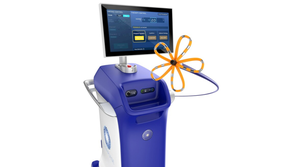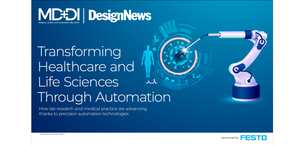An analysis of regional patenting strength provides key insights for medical device companies undertaking the site selection process.
November 1, 2006
 GOVERNMENTAL & LEGAL AFFAIRS
GOVERNMENTAL & LEGAL AFFAIRS
Long ago, site selection became a very sophisticated and highly strategic decision for most companies. Recent advances in geographic information selection software packages enable companies to meld important factors in site selection—such as population, income taxes, airport accessibility, highway conditions, and even nearby employers and colleges—when evaluating prospective sites. Additionally, several large real estate organizations, including Trammell Crow Co. (Dallas) and the Staubach Co. (Addison, TX), have formed industry-specific teams to further their business development efforts in fast-growing, innovative industries such as life sciences.
However, missing from most typical site selection processes is a thorough examination of the elements that underscore innovation in life sciences segments such as medtech: inventors and the intellectual property (IP) they produce. Numerous studies have linked high-quality patents to market success. Therefore, if a company manages its IP as a core asset, innovation—particularly high-quality, patent-driven innovation—is a repeatable process that can lead to such market success.
In this MX exclusive, intellectual property research and advisory services firm ipIQ (Chicago) examines how IP analytics can enhance site selection for medtech companies.
Medtech Inventor Contributions by State
To identify hot spots in terms of industry-specific patenting activity, ipIQ examined inventor contributions in the medical device field by geographic region. Inventor contribution is defined as the number of contributions made to an issued patent by an individual inventor in a specific geographical area. For example, if three inventors from the Chicago area were to collaborate on five different patents, Chicago would be credited with 15 contributions. For the study, ipIQ focused on U.S. utility patents issued from 2003 to the present.
At the national level, the number of inventor contributions to medical device patents declined at an annual rate of 14% between 2003 and 2005. The decline in contributions is prevalent among the top 10 states, with only Pennsylvania showing an annual decline of less than 10% in this time frame. Shrinking by more than 19% in 2004 and 27% in 2005, Ohio experienced the greatest reduction in annual contributions among the top 10 states.
Even though the medtech industry is generally thought to be less concentrated geographically than other life sciences segments such as biotech and pharma, the degree of inventor concentration in the medical device field is worthy of note. About half of the inventor contributions to medical device patents issued since 2003 originate from only four states—California, Massachusetts, Minnesota, and New York (see Table I).
State | Medtech Inventor | % of U.S. Medtech | Unique Medtech |
California | 18,497 | 28.6 | 9124 |
Massachusetts | 5335 | 8.2 | 2803 |
Minnesota | 5235 | 8.1 | 2803 |
New York | 3369 | 5.2 | 2162 |
New Jersey | 2438 | 3.8 | 1538 |
Ohio | 2323 | 3.6 | 1332 |
Pennsylvania | 2217 | 3.4 | 1406 |
Florida | 2069 | 3.2 | 1596 |
Illinois | 2064 | 3.2 | 1156 |
Texas | 1850 | 2.9 | 1372 |
Table I. The number of inventor contributions to medical device patents and unique medtech patents produced by the top 10 U.S. states, January 2003-June 2006. Source: iplQ. |
Not surprisingly, California leads all states with more than a quarter of the nation's medtech inventor contributions, yielding more than 9000 patents.
When looking beyond the lump sum of patents produced in each state, some interesting observations come to light in terms of the quality and productivity of the patents produced in each state. They are as follows.
Minnesota, not California, has the highest average number of inventors per patent (inventor contributions/unique patent count).
With 22 inventor contributions to 21 patents in 2005, North Dakota ranks ahead of only Alaska in terms of inventor contributions. However, this set of patents scored the highest of all states in 2005 when measured by ipIQ's Current Impact Index (CII), a proprietary measure of the impact that a company's patents have across the industry (see sidebar). North Dakota's CII score of 3.03 is nearly three times that of industry-leading California, Massachusetts, and Minnesota.
On average, patents produced by Kentucky inventors have the highest interdependency scores per patent at 1.9. This score is 6.33 times more than that of South Dakota, the state receiving the fewest average citations per patent. Interdependency illustrates foundational patents that are key building blocks to other innovations.
While these data points may not necessarily dictate that a medical device company should relocate to North Dakota, they may cause medtech executives to consider locations that might otherwise not appear on their list of prospects. For example, low-cost locations in close proximity to both Minneapolis and eastern North Dakota would situate a company between a major medtech hub and a region of the nation producing exceptionally high-quality patents. Similarly, with the insight that inventors living in Kentucky have discovered some potentially seminal patents in the medical device field, some companies might consider the Cincinnati-Northern Kentucky region a more attractive site.
Medtech Inventor Contributions by Region
Similar to the state-by-state breakdown, an analysis of inventor contributions at the core-based statistical area (CBSA) level paints a highly concentrated picture. In fact, since 2003, the top 10 CBSAs have generated 51% of the nation's inventor contributions to medical device patents (see Table II). CBSAs encompass both metropolitan and micropolitan statistical areas as defined by the U.S. Office of Management and Budget. A look at ipIQ's patent quality indicators reveals the following information at the CBSA level.
Core-Based Statistical Areas
Medtech
Inventor
Contributions
(no.)% of U.S.
Medtech
ContributionsUnique
Medtech
Patents
(no.)San Francisco–Oakland–Fremont, CA
5159
8.0
3215
Minneapolis–St. Paul–Bloomington, MN- WI
5129
7.9
2232
San Jose–Sunnyvale–Santa Clara, CA
4881
7.5
3027
Boston-Cambridge-Quincy, MA-NH
4797
7.4
2617
Los Angeles–Long Beach–Santa Ana, CA
4548
7.0
2707
New York–New Jersey–Long Island, NY- NJ-PA
3467
5.4
2264
Chicago-Naperville-Joilet, IL-IN-WI
1878
2.9
1009
San Diego–Carlsbad–San Marcos, CA
1826
2.8
1247
Philadelphia-Camden-Wilmington, PA- NJ-DE-MD
1439
2.2
900
Seattle-Tacoma-Bellevue, WA
1306
2.0
771
Table II. The number of inventor contributions to medical device patents and unique medtech patents produced by the top 10 U.S. core-based statistical areas (CBSAs), January 2003–June 2006. Source: iplQ.
Minneapolis–St. Paul–Bloomington has the highest average inventors-per-patent ratio among the top 20 CBSAs for medical device patents.
Houston-Sugarland-Baytown in Texas has the lowest average inventors-per-patent ratio among the top 20 CBSAs for medical device patents. It also has the lowest CII score among the top 20.
San Jose–Sunnyvale–Santa Clara in California has the highest CII and average interdependencies- per-patent ratio.
San Diego–Carlsbad–San Marcos: Not only is the San Diego life sciences community one of the most productive, but as it has grown, the community has also started to attract many commuters from Orange County. Its connection to medtech companies such as Beckman Coulter (Fullerton, CA) and access to UC Irvine complement the already strong San Diego academic and research institutions.
Patent Quality by State
In addition to analyzing the quantity of patents produced in an individual region, it's also important to determine the relative quality of a region's patents. In examining the top 10 states in terms of medtech patent quality—as measured by ipIQ's technology strength indicator—the following observations come to light (see Table III).
State
Inventor
Contribution
RankTechnology
Strength RankTechnology
StrengthIssued
PatentsCurrent Impact
IndexScience
LinkageTechnology
Cycle TimeCalifornia
1
1
2692
2264
1.19
7.7
9.3
Massachusetts
2
2
710
660
1.08
10.0
9.1
Minnesota
3
3
564
596
0.95
4.3
8.2
New York
4
4
406
509
0.80
5.0
7.7
Pennsylvania
7
5
361
373
0.97
5.4
10.2
Florida
8
6
330
405
0.82
3.6
9.9
Ohio
6
7
313
298
1.05
3.8
9.6
New Jersey
5
8
283
364
0.78
6.2
9.1
Texas
10
9
258
309
0.83
6.7
10.1
Illinois
9
10
238
293
0.81
6.2
11.1
Table III. The medical device industry's top 10 states, ranked based on the technology strength of their patent portfolios, 2003–2005. The green and red highlighting indicates notably strong and weak performances, respectively, as outlined in the article. Source: iplQ.
The technology strength indicators of medtech patents produced in Pennsylvania, Florida, and Texas are higher than their inventor contribution rankings, meaning the patents produced in these states are of comparatively higher quality. On the other hand, the technology strength indicators for Ohio, New Jersey, and Illinois are relatively weaker than might be expected based on their inventor contribution rankings.
California tends to produce the medtech patents that have the most influence within the industry, as indicated by its CII score of 1.19.
Massachusetts generates the medtech patents that are most closely related to leading-edge research, as indicated by its 10.0 science linkage score.
New York produces medtech patents the most quickly, as indicated by its technology cycle time of 7.7, the lowest among the top 10 states. However, New York's industry influence score (CII) of 0.80 is the second lowest among the top 10 states.
Conclusion
Although the site selection process has evolved to include numerous factors, such as traffic density, tax rates, and projected population growth, many of the forces that drive innovation—intellectual property, patents, and research—have historically not been a significant part of the site selection algorithm. In order for a medical device company to best align its need for continued market-leading innovation with its need for an appropriate location, fact-based analytics regarding high-quality patenting within geographies is a key component.
Consideration of numerous quality-of-life inputs is undeniably important when choosing a location. However, without understanding an area's ability to produce innovation, a medtech company's site selection process might not lead to the best possible location to meet the company's long-term needs. Scott Kratzer is vice president of advisory services for intellectual property research and advisory services firm ipIQ (Chicago). Jorge Diaz is an analyst in the firm's advisory services division.
Scott Kratzer is vice president of advisory services for intellectual property research and advisory services firm ipIQ (Chicago). Jorge Diaz is an analyst in the firm's advisory services division.
Copyright ©2006 MX
About the Author(s)
You May Also Like


